In situ recycling of particulate matter for a high-performance supercapacitor and oxygen evolution reaction†
Abstract
Particulate matter (PM), a major environmental pollutant, poses serious threats to the environment and public health. With an achievement by converting toxic contaminants into valuable products, this research explores the waste-turned treasures of exhaust PM pollution. Here, we rationally design a PM filter composed of homogeneously decorated zeolite imidazole framework-67 (ZIF-67) on a porous network of reduced graphene oxide aerogel (named as ZIF-67/rGA). The ZIF-67/rGA captures PM with excellent removal efficiency both in dynamic and static systems as a result of impressive specific surface area, continuous 3D networks, and numerous active sites. Highly porous Co3O4/N-rGA derived from PM@ZIF-67/rGA is achieved via an in situ thermal carbonization and activation process. The synergistic effect of porous Co3O4 nanoparticles and rich N-doped graphene aerogel contributes to the unprecedented electrochemical performance. Co3O4/N-rGA demonstrated a superior capacitance of 1485 F g−1 at 1 A g−1, which is superior to that of Co3O4/r-GA (249 F g−1 at 1 A g−1) obtained by direct pyrolysis of ZIF-67/r-GA. Meanwhile, it also displays an enhanced electrocatalytic performance (low overpotential of 367 mV at 10 mA cm−2) for the oxygen evolution reaction (OER) in alkaline solution. The findings provide a novel route to resolve environmental pollution and search for energy storage and conversion materials.



 Please wait while we load your content...
Please wait while we load your content...